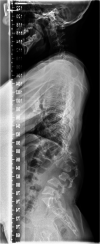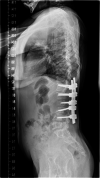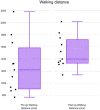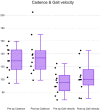Improvement in functional gait parameters following corrective thoracolumbar surgery in children affected by Mucopolysaccharidosis 1 (Hurler syndrome)
- PMID: 32503603
- PMCID: PMC7275619
- DOI: 10.1186/s13023-020-01427-3
Improvement in functional gait parameters following corrective thoracolumbar surgery in children affected by Mucopolysaccharidosis 1 (Hurler syndrome)
Abstract
Objective: Thoracolumbar kyphosis is a common indication for spinal surgery in children with Mucopolysaccharidosis. Functional outcome of spinal surgical intervention has never been published in patients with this rare disease. We present a cohort of patients with Mucopolysaccharidosis 1(Hurler syndrome) who underwent thoraco-lumbar spinal deformity correction and functional outcome assessed by pre-operative and post-operative gait analysis. This study represents the first attempt at presenting a functional assessment of surgical outcome in any Mucopolysaccharidosis subtype.
Methods: A retrospective analysis of prospectively collected data was carried out from 11 children diagnosed with this subtype of Mucopolysaccharidosis. All patients underwent thoracolumbar kyphosis correction between the years 2013 to 2016. Gait assessment was performed using GAITRite™ electronic walkway pre-operatively and post-operatively within 9 to 24 months from the index surgery. Walking distance, cadence and gait velocity were the three spatio-temporal parameters analysed. Wilcoxon signed rank test was used to analyse the data and P-Value ≤0.05 was deemed significant.
Results: There was a statistically significant improvement in walking distance in 9 out of 11 patient post-operatively with a mean increase of 232.06 cms (P = 0.05). There was marginal improvement in cadence by 6.33 steps/min post-operatively (P-value 0.79). Gait velocity also showed a marginal increase by 8.73 cms/sec post-operatively (P-value 0.32).
Conclusion: The results of our study suggest that correction of thoracolumbar kyphosis in children with Mucopolysaccharidosis 1 resulted in a significant improvement of walking distance with a trend towards improved gait in the other parameters. Post-operative change in cadence was not statistically significant suggesting that physiological maturation of gait had minimal effect in the specified post-operative assessment timeframe. This study emphasizes that outcomes of spinal surgery in children with Mucopolysaccharidosis 1 should be determined by functional measures aiming to maintain or improve quality of life.
Keywords: Functional outcome; Gait; Kyphosis; Mucopolysaccharidosis 1; Spinal surgery.
Conflict of interest statement
Dr. Simon Jones is an investigator with Sanofi Genzyme. He receives consulting fees and speaking fees for MPS1.
Mr. Neil Oxborrow has an educational contract with Biomarin and receives a speaker’s fee.
Figures





Similar articles
-
Thoracolumbar kyphosis in treated mucopolysaccharidosis 1 (Hurler syndrome).Spine (Phila Pa 1976). 2014 Mar 1;39(5):381-7. doi: 10.1097/BRS.0000000000000157. Spine (Phila Pa 1976). 2014. PMID: 24573070
-
Thoracolumbar kyphosis in patients with mucopolysaccharidoses: clinical outcomes and predictive radiographic factors for progression of deformity.Bone Joint J. 2016 Feb;98-B(2):229-37. doi: 10.1302/0301-620X.98B2.36144. Bone Joint J. 2016. PMID: 26850429
-
A modified posterior wedge osteotomy with interbody fusion for the treatment of thoracolumbar kyphosis with Andersson lesions in ankylosing spondylitis: a 5-year follow-up study.Chin Med J (Engl). 2020 Jan 20;133(2):165-173. doi: 10.1097/CM9.0000000000000594. Chin Med J (Engl). 2020. PMID: 31929366 Free PMC article.
-
Surgical Management of Thoracolumbar Kyphosis in Patients With Mucopolysaccharidosis: A Systematic Review.Spine (Phila Pa 1976). 2017 Dec 1;42(23):1817-1825. doi: 10.1097/BRS.0000000000002242. Spine (Phila Pa 1976). 2017. PMID: 28538597
-
Enzyme replacement therapy with laronidase (Aldurazyme®) for treating mucopolysaccharidosis type I.Cochrane Database Syst Rev. 2019 Jun 18;6(6):CD009354. doi: 10.1002/14651858.CD009354.pub5. Cochrane Database Syst Rev. 2019. PMID: 31211405 Free PMC article.
References
MeSH terms
LinkOut - more resources
Full Text Sources

